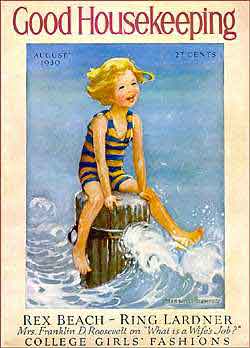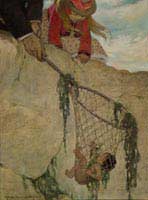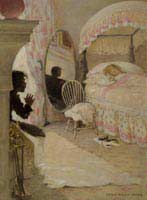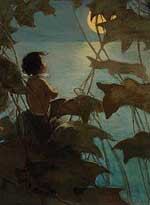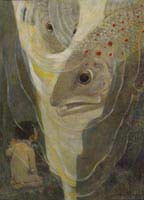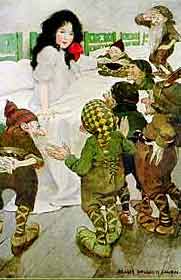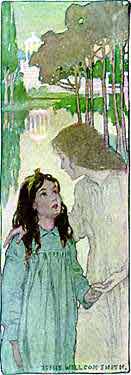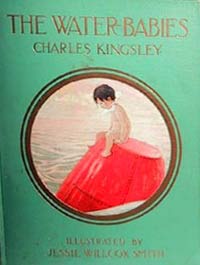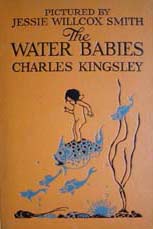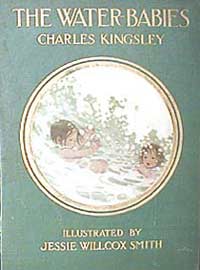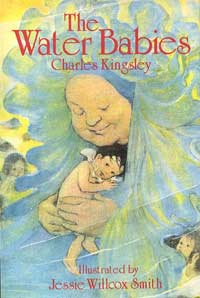Charles
Kingsley scrisse The Water Babies, sottotitolato
Fairy Tale for a Land Baby, per il figlioletto
Grenville. Inizialmente venne pubblicato a puntate sul Macmillan's
Magazine tra il 1862 e il 1863,anno in cui fu i pubblicato in volume
con illustrazioni di Noel Paton. Appartenente al genere fantasy,
narra la storia di Tom, un piccolo spazzacamino costretto a lavorare
per il cattivo Mr Grimes. Un giorno Tom cade giù per un camino
e si trova alla presenza di una bella bambina, Ellie. Ellie è
pulitissima e Tom si rende conto della propria sporcizia. Si precipita
fuori e cade nel fiume. Allora entra in un magico mondo e diventa un
bambino dell'acqua (water-baby). Qui ha una serie di incontri, compresi
animali e personaggi strani, e vive diverse avventure. Infine i cattivi
vengono puniti e, in virtù del suo buon comportamento, e per
aver fatto il suo dovere, anche se spiacevole, Tom torna ad essere un
bambino normale (e pulito). L'essenzialità del racconto sta infatti
tutta in una frase:
“Those that wish to be clean, clean they will be; and those that wish
to be foul, foul they will be.”
Come Alice's
Adventures in Wonderland di Lewis Carroll o The Sword in the
Stone di White, o Peter Pan di Barrie, questo tipo di
letteratura esplora le possibilità di mondi alternativi a quello
reale, non dimenticando di presentarne la morale (spesso in contrapposizione
alla sua mancanza nel mondo reale) sotto forma di insegnamenti provenienti
dai personaggi fantastici (inclusi gli animali). Questo tipo di letteratura
per l'infanzia è tipico della fine del XIX secolo, dove si tendeva
a insegnare la morale a coloro che si supponeva ne fossero privi (i
poveri). Inoltre, vi è una buona dose di moralismo verso lo sfruttamento
dei minori, non diversamente che nell'Oliver Twist di Dickens.
CHARLES
KINGSELY (1819 - 1875)
Charles
Kingsley, ministro della Chiesa Anglicana, nacque in una parrocchia
situata a Clovelly, sulla costa nord del Devonshire e trascorse la
maggior parte della sua vita in un'altra, ad Eversley, nello Hampshire,
dove venne nominato curato nel 1842 e dove morì nel 1875. Il
titolo onorifico di Canonico di Westminster gli fu conferito dalla
Regina Vittoria, che leggeva The Water Babies ai suoi figli.
Kingsley pubblicò moltissimi racconti e sermoni; per mezzo
della scrittura volle portare l'attenzione sui problemi sociali del
proprio tempo.
The Water Babies è un classico della
letteratura inglese infantile, ed ebbe un immediato successo che dura
tuttora. Il romanzo originale è assai lungo, per cui lo stesso
Kingsley ne autorizzò anche delle edizioni ridotte.
Altre
opere di Kingsley:
Hereward the Wake
Westward Ho!
Yeast
Alton Locke
The Heroes
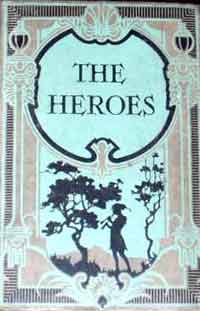
The
Heroes, London, Oxford University Press, n.d.,
Herbert Strang's Library
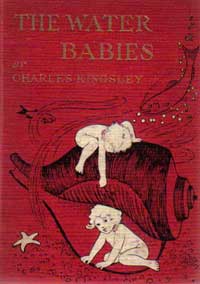
The
Water Babies, J B Lippincott, 1917, include 8 tavole a colori,
ill. by Maria L. Kirk
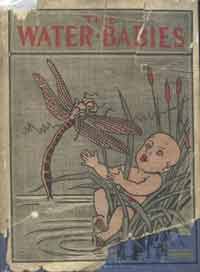
The Water Babies, David
McKay, Philadelphia, 1920,
incluse 4 tavole a colori
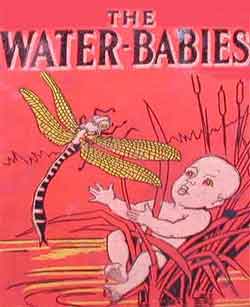
The
Water Babies, David McKay Company, Inc., Philadelphia,
include 4 tavole a colori, n.d.
L'EDIZIONE ILLUSTRATA PIU' FAMOSA E' QUELLA DI JESSIE WILLCOX-SMITH
(1916)
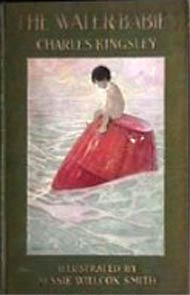
The
Water Babies,
New York: Dodd and Mead Company, 1916, ill. by
Jessie Willcox Smith, cover,
include 12 tavole a colori
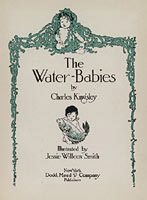
The Water Babies,
New York: Dodd and Mead Company, 1916, ill. by
Jessie Willcox Smith, front
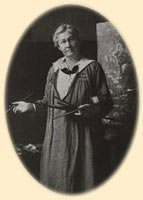
Color photograph of
Jessie Willcox Smith,
published in Good Housekeeping ,
v. 65, p. 32, November 1917
Ulteriori notizie su Jessie Willcox-Smith sono nel volume
The
Red Rose Girls
by Alice A. Carter
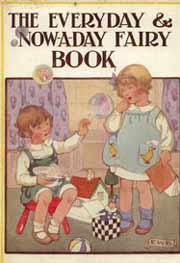
Anna Alice Chapin,
The Everyday & Now-A-Day Fairy Book, London, J. Cocker,
ca. 1930, incluse 8 tavole a colori by Jessie Willcox-Smith
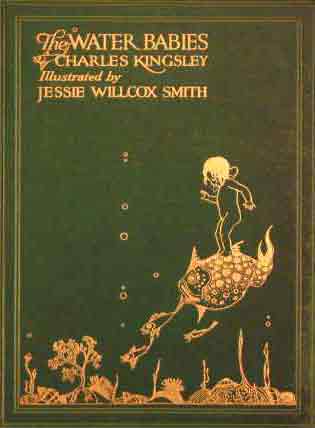
The Water Babies, London, Hodder
and Stoughton, 1929, ill. by Jessie Willcox-Smith
ALCUNE
EDIZIONI MODERNE DI THE WATER BABIES
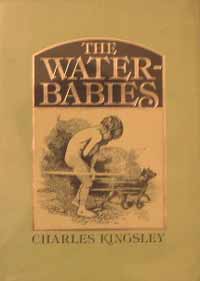 |
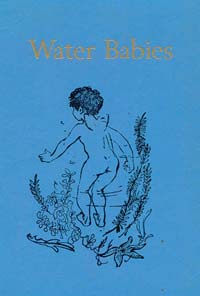 |
|
The
Water Babies, McMillan & Co., London, 1979 (riproduzione
dell'originale del 1928)
|
The
Water Babies, International Leading Systems, 1968, ill.
by Charles Mozley
|
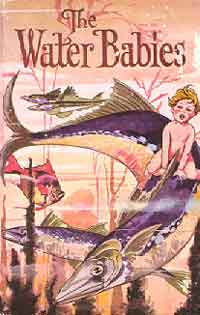 |
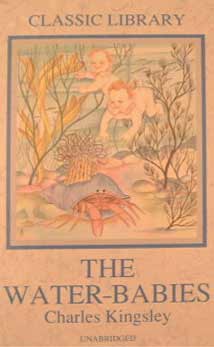 |
|
The
Water Babies, The Children's Press, London, 1974
|
The
Water Babies, World International Publishing Ltd., Manchester,
1990, include 8 tavole a colori, ill. by Cathy Simpson
|
|
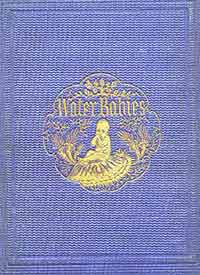
The
Water Babies: A Fairy Tale for a Land Baby
Burnham, 1864
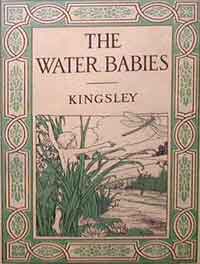
The
Water Babies, Ginn & Company, new York, 1916,
ill. by Florence Liley Young
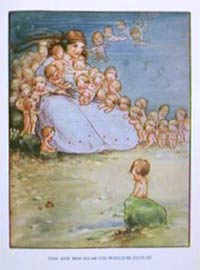
The
Water Babies, London, 1920, Raphael Tuck, edited by Capt.
Edric Uredenburg, ill. interna by Mabel Lucie Attwell
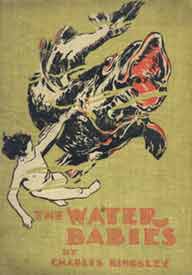
The
Water Babies, Wessels, New York, 1900, ill. by G. Wright
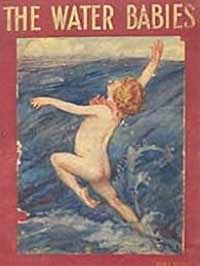
The
Water Babies, Thomas Nelson & Sons, London, 1911,
include 4 tavole a colori, ill. by A. Jackson
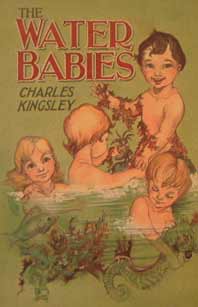
The
Water Babies, Macmillan, London, 1912, include frontispiece
e
15 tavole a colori, ill. by Goble
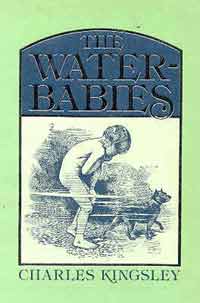
The Water Babies, Godfrey Cave Asosciates/McMillan &
Co., London,
1928, ill. by Linley Sambourne
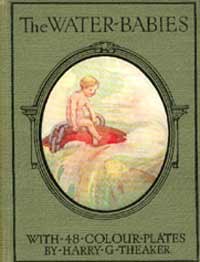
The Water Babies, London, Ward Lock, ca. 1930, ill.
by Harry G. Theaker
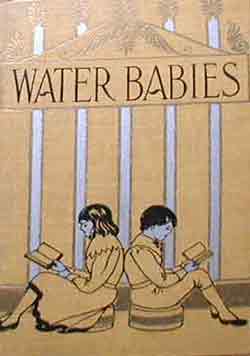
The Water Babies, H.M. Caldwell Company Cloth, New York,
n.d.
|
Jessie
Willcox Smith (1863-1935)
Nacque
a Philadelphia e fece l'insegnante per le prime classi, prima
di scoprire di avere un talento per il disegno quando aveva
già passato i 20 anni. Si iscrisse allora alla Pennsylvania
Academy of the Fine Arts; diplomatasi nel 1888,
iniziò una carriera che l'avrebbe portata alla notorietà.
I primi lavori apparvero in un mensile per bambini, il St.
Nicholas, poi nel Ladies' Home Journal, e nel
1889 si iscrisse al Drexel Institute of Arts and
Sciences, dove insegnava Howard Pyle. La prima
commissione che le procurò Pyle fu per l'edizione del
1897 di Evangeline, che illustrò insieme con
Violet Oakey. Insieme ad un'altra allieva di Pyle,
Elizabeth Shippen Green, le tre illustratrici instaurarono un
sodalizio che durò per l'intera vita: nel 1901 aprirono
uno studio insieme, The Red Rose Inn. Jessie Willcox-Smith
illustra The Ladies' Home Journal, Century,
Collier's Weekly, Leslie's, Harper's,
McClure's, Scribners' A Child's Garden of Verses,
In A Closed Room di France Hodgson Burnett. Col tempo
si specializza nel disegnare bambini; i suoi lavori migliori
sono infatti A Child's Book of Stories (1911), The
Water-Babies (1916), At the Back of the North Wind
(1919), and Boys and Girls of Bookland (1923), Dickens'
Children (1912), The Everyday Fairy Book (1915),
A Child's Book of Modern Stories (1920), un'edizione
di Heidi.
Ma sono le copertine di Good Housekeeping che
le danno la notorietà. Per oltre 15 anni illustrò
le copertine di una delle riviste più popolari d'America.
Naturlamente la sua produzione include ritratti, poster e pubblicità.
|
The
Water Babies,
New York: Dodd and Mead Company, 1916, ill. by
Jessie Willcox Smith, 4
tavole a colori
ALCUNE
EDIZIONI MODERNE DI THE WATER BABIES ILLUSTRATE DA JESSIE WILLCOX-SMITH
che riprendono in copertina le illustrazioni originali
|
|
Chapter
1
“
I heard a thousand blended notes,
While in a grove I sate reclined;
In that sweet mood when pleasant thoughts
Bring sad thoughts to the mind . “ To her fair works
did Nature link
The human soul that through me ran;
And much it grieved my heart to think,
What man has made of man .”
—Wordsworth.
Once
upon a time there was a little chimney-sweep, and his name was
Tom. That is a short name, and you have heard it before, so
you will not have much trouble in remembering it. He lived in
a great town in the North country, where there were plenty of
chimneys to sweep, and plenty of money for Tom to earn and his
master to spend. He could not read nor write, and did not care
to do either; and he never washed himself, for there was no
water up the court where he lived. He had never been taught
to say his prayers. He never had heard of God, or of Christ,
except in words which you never have heard, and which it would
have been well if he had never heard. He cried half his time,
and laughed the other half. He cried when he had to climb the
dark flues, rubbing his poor knees and elbows raw; and when
the soot got into his eyes, which it did every day in the week;
and when his master beat him, which he did every day in the
week; and when he had not enough to eat, which happened every
day in the week likewise. And he laughed the other half of the
day, when he was tossing halfpennies with the other boys, or
playing leap-frog over the posts, or bowling stones at the horses'
legs as they trotted by, which last was excellent fun, when
there was a wall at hand behind which to hide. As for chimney-sweeping,
and being hungry, and being beaten, he took all that for the
way of the world, like the rain and snow and thunder, and stood
manfully with his back to it till it was over, as his old donkey
did to a hail- storm; and then shook his ears and was as jolly
as ever; and thought of the fine times coming, when he would
be a man, and a master sweep, and sit in the public-house with
a quart of beer and a long pipe, and play cards for silver money,
and wear velveteens and ankle-jacks, and keep a white bull-dog
with one gray ear, and carry her puppies in his pocket, just
like a man. And he would have apprentices, one, two, three,
if he could. How he would bully them, and knock them about,
just as his master did to him; and make them carry home the
soot sacks, while he rode before them on his donkey, with a
pipe in his mouth and a flower in his button-hole, like a king
at the head of his army. Yes, there were good times coming;
and, when his master let him have a pull at the leavings of
his beer, Tom was the jolliest boy in the whole town.
One
day a smart little groom rode into the court where Tom lived.
Tom was just hiding behind a wall, to heave half a brick at
his horse's legs, as is the custom of that country when they
welcome strangers; but the groom saw him, and halloed to him
to know where Mr. Grimes, the chimney-sweep, lived. Now, Mr.
Grimes was Tom's own master, and Tom was a good man of business,
and always civil to customers, so he put the half-brick down
quietly behind the wall, and proceeded to take orders.
Mr.
Grimes was to come up next morning to Sir John Harthover's,
at the Place, for his old chimney- sweep was gone to prison,
and the chimneys wanted sweeping. And so he rode away, not giving
Tom time to ask what the sweep had gone to prison for, which
was a matter of interest to Tom, as he had been in prison once
or twice himself. Moreover, the groom looked so very neat and
clean, with his drab gaiters, drab breeches, drab jacket, snow-white
tie with a smart pin in it, and clean round ruddy face, that
Tom was offended and disgusted at his appearance, and considered
him a stuck-up fellow, who gave himself airs because he wore
smart clothes, and other people paid for them; and went behind
the wall to fetch the half- brick after all; but did not, remembering
that he had come in the way of business, and was, as it were,
under a flag of truce.
His
master was so delighted at his new customer that he knocked
Tom down out of hand, and drank more beer that night than he
usually did in two, in order to be sure of getting up in time
next morning; for the more a man's head aches when he wakes,
the more glad he is to turn out, and have a breath of fresh
air. And, when he did get up at four the next morning, he knocked
Tom down again, in order to teach him (as young gentlemen used
to be taught at public schools) that he must be an extra good
boy that day, as they were going to a very great house, and
might make a very good thing of it, if they could but give satisfaction.
....continues
|
|
Chapter
8
........
Oh,
you may see him any clear night in July; for the old dog-star
was so worn out by the last three hot summers that there have
been no dog-days since; so that they had to take him down and
put Tom's dog up in his place. Therefore, as new brooms sweep
clean, we may hope for some warm weather this year. And that
is the end of my story.
Moral.
And
now, my dear little man, what should we learn from this parable?
We
should learn thirty-seven or thirty-nine things, I am not exactly
sure which: but one thing, at least, we may learn, and that
is this - when we see efts in the pond, never to throw stones
at them, or catch them with crooked pins, or put them into vivariums
with sticklebacks, that the sticklebacks may prick them in their
poor little stomachs, and make them jump out of the glass into
somebody's work-box, and so come to a bad end. For these efts
are nothing else but the water-babies who are stupid and dirty,
and will not learn their lessons and keep themselves clean;
and, therefore (as comparative anatomists will tell you fifty
years hence, though they are not learned enough to tell you
now), their skulls grow flat, their jaws grow out, and their
brains grow small, and their tails grow long, and they lose
all their ribs (which I am sure you would not like to do), and
their skins grow dirty and spotted, and they never get into
the clear rivers, much less into the great wide sea, but hang
about in dirty ponds, and live in the mud, and eat worms, as
they deserve to do.
But
that is no reason why you should ill-use them: but only why
you should pity them, and be kind to them, and hope that some
day they will wake up, and be ashamed of their nasty, dirty,
lazy, stupid life, and try to amend, and become something better
once more. For, perhaps, if they do so, then after 379,423 years,
nine months, thirteen days, two hours, and twenty-one minutes
(for aught that appears to the contrary), if they work very
hard and wash very hard all that time, their brains may grow
bigger, and their jaws grow smaller, and their ribs come back,
and their tails wither off, and they will turn into water- babies
again, and perhaps after that into land-babies; and after that
perhaps into grown men.
You
know they won't? Very well, I daresay you know best. But you
see, some folks have a great liking for those poor little efts.
They never did anybody any harm, or could if they tried; and
their only fault is, that they do no good - any more than some
thousands of their betters. But what with ducks, and what with
pike, and what with sticklebacks, and what with water-beetles,
and what with naughty boys, they are “sae sair hadden doun,”
as the Scotsmen say, that it is a wonder how they live; and
some folks can't help hoping, with good Bishop Butler, that
they may have another chance, to make things fair and even,
somewhere, somewhen, somehow.
Meanwhile,
do you learn your lessons, and thank God that you have plenty
of cold water to wash in; and wash in it too, like a true Englishman.
And then, if my story is not true, something better is; and
if I am not quite right, still you will be, as long as you stick
to hard work and cold water.
But
remember always, as I told you at first, that this is all a
fairy tale, and only fun and pretence: and, therefore, you are
not to believe a word of it, even if it is true.
|
|









